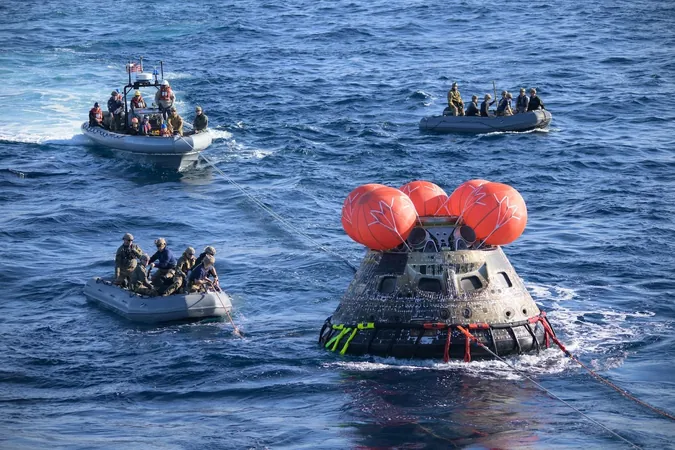
NASA's Mysterious Silence: What’s at Stake with Orion's Heat Shield?
2024-10-29
Author: Daniel
Introduction
NASA has finally pinpointed the root cause of the erosion issues with the heat shield of its Orion spacecraft, which made headlines after its historic journey to the Moon in 2022. However, the agency remains tight-lipped about the specifics—creating waves of intrigue among space enthusiasts and experts alike.
Discovery of the Root Cause
During a recent meeting of the Lunar Exploration Analysis Group (LEAG) held in Houston, NASA representatives confirmed they had identified the reason for the unexpected deterioration of the heat shield during the Artemis 1 mission. Lori Glaze, acting deputy associate administrator at NASA’s Exploration Systems Development Mission Directorate, asserted, 'We have conclusive determination of what the root cause is of the issue. I’m not going to share right now; when it comes out, it will all come out together.' This cryptic communication adds to the urgency and speculation surrounding the upcoming Artemis 2 mission, scheduled for launch in September 2025.
The Artemis 1 Mission
The Artemis 1 mission concluded successfully with an uncrewed Orion capsule splashing down in the Pacific Ocean on December 11, 2022. Nonetheless, subsequent inspections revealed concerning damage to the heat shield. During reentry, Orion faced blistering conditions, reaching speeds of 24,600 miles per hour (39,590 kilometers per hour) and enduring temperatures soaring over 5,000 degrees Fahrenheit. While NASA engineers had expected some erosion, the scale of the heat shield's wear caught them off guard.
Ongoing Evaluations and Safety Concerns
Currently, NASA is conducting additional tests and evaluations to devise a plan to reduce the risk of similar damage during atmospheric reentry in future missions. The urgency of addressing this issue has been underscored by a report from the NASA Office of Inspector General earlier this year, which flagged the heat shield as a critical concern for the Artemis 2 mission. It highlighted that the heat shield's char layer deteriorated in ways that differed drastically from engineers’ predictions, leading to fragmentation and debris loss rather than the controlled melting intended.
Crew Safety and Mission Readiness
Furthermore, there is growing concern regarding the safety of the crew set to embark on Artemis 2. NASA has indicated that adjustments may need to be made either by altering the heat shield or by adjusting Orion’s reentry trajectory—challenges that become significantly more complicated with the heat shield already installed.
Commitment to Safety
In August 2023, NASA astronaut Reid Wiseman, soon to command the Artemis 2 mission, emphasized the commitment to safety, stating, 'We’re not going to launch until we know we’re ready, until our team knows that the vehicle is ready, and we will keep the pressure on.'
Speculation and Implications
Speculation about why NASA is withholding information continues to swirl. Are the revelations too dire for the public? Officials’ hesitance to disclose details could hint at deeper implications—potentially leading to further delays in the Artemis program, which has already seen its timeline pushed back due to safety and technical concerns. Originally eyeing a November 2024 launch, Artemis 2's timeline now stretches to September 2025, while Artemis 3, initially planned for late 2025, won't take off before September 2026.
Conclusion
As the world watches and waits, one thing is clear: the success of NASA's Artemis program hangs in the balance, caught between ambition and the unforgiving realities of space exploration. Will Orion’s heat shield become a barrier to humanity’s return to lunar soil, or will NASA overcome this hurdle and unveil the mysteries it holds? Only time will tell.


 Brasil (PT)
Brasil (PT)
 Canada (EN)
Canada (EN)
 Chile (ES)
Chile (ES)
 España (ES)
España (ES)
 France (FR)
France (FR)
 Hong Kong (EN)
Hong Kong (EN)
 Italia (IT)
Italia (IT)
 日本 (JA)
日本 (JA)
 Magyarország (HU)
Magyarország (HU)
 Norge (NO)
Norge (NO)
 Polska (PL)
Polska (PL)
 Schweiz (DE)
Schweiz (DE)
 Singapore (EN)
Singapore (EN)
 Sverige (SV)
Sverige (SV)
 Suomi (FI)
Suomi (FI)
 Türkiye (TR)
Türkiye (TR)